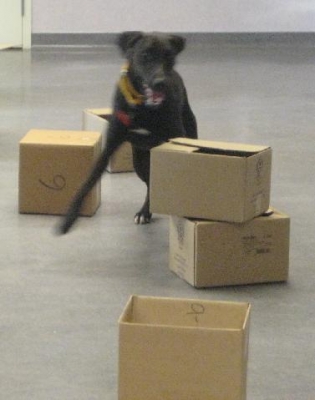Getting Started in Nose Work

I have written about K9 Nose Work and folks have been asking me about what is needed to get started and the best way to introduce their dogs to a more formal nose work routine. The greatest thing about doing K9 Nose Work is how easy it is and portable it can be. Your dog’s nose goes everywhere and the world is an adventure.
My training partners and I generally start all dogs in class using cardboard boxes for searching. You can use any type of container such as shoe boxes, Tupperware with holes punched in the top, flower pots, etc. You’ll want to contain the odor, yet leave enough ventilation for it to be accessible to the dog. The greener the dog the more accessible the odor should be. We have found card board boxes to be the easiest and most cost effective. We start with 5 or 6 and the number and difficulty grows with time and experience.
The containers do not need to match, but for the purest you can purchase matching boxes and mark the one you’ll primarily use to hide your dog’s target. Try to limit cross-contaminating the other boxes. In the beginning you will want to keep it as clear cut as possible so your dog finds consistent success. We use the boxes to help the dog learn the game and it can become a cue in the beginning that the game is on. Additionally, it doesn’t matter at first if the dog can see the hidden item. We want to encourage the dog seek it out.
Your first step is to find out what your dog really, really loves. Not likes, LOVES! That is what you will start with as the target for your dog’s search. Our goal in the beginning is not to teach the end result first, but to help the dog build their desire to hunt and scent independently.
As simple as this may sound, many dogs are reluctant to venture out on their own or stray away from obedience mode. It can take a bit of convincing that it is not a set up and they are free to search. Some dogs are gung-ho and the biggest challenge will be reeling them in and getting them to focus on the task.
Our goal for the handlers in the Introduction to Nose Work class is for them to learn how to read their dogs and to pick up on the subtle signals that their dogs communicate with when they are on the trail of their target. Video taping your dog searching will help you identify those subtle body and breathing changes that happen when your dog is close to finding his bounty.
Whether you are using food or toys is not relevant, only that your dog is motivated to hunt for it. There are advantages and disadvantages to either food or toys as targets and then as rewards. We will discuss this in a later post.
When starting your dog, working with a training partner is helpful, but not mandatory. If you are training independently you will need to be able to back tie your dog so you can entice them and hide the reward with out them following you from box to box. If you are using food have the food in a pouch or ventilated small container and keep a few extras on your person. We keep the food in containers so the food doesn’t leave excess residue on the boxes.
With your dog restrained, start pretending to hide their goodies or toy and mix it up so the dog doesn’t see which box has the hide. You will still use the same box each time, just move it around. It is like playing a shell game. After you place their reward move around to other boxes and go to a box furthest away from where you actually left the loaded box. If you are sneaky your dog will look at the last box you visited and from there the search begins. Try to avoid helping them or pointing at each box; ideally, your dog should search on their own.
If your dog is reluctant to move away from you, casually stroll around as if you are just going for a walk. If your dog needs a bit more encouragement, nonchalantly investigate the boxes (avoiding the loaded box). As soon your dog shows ANY level of interest in the box with the reward run over and with enthusiasm tell them how wonderful they are and either give them a goodie or play tug with their toy right at the box. REWARD AT THE BOX! (More on why in later post.)
Start in an enclosed secure area so you can work your dog both on and off leash. Keep your sessions short and fun. Limit using any obedience commands when building the searching desire in your dog. It is important that the dog learns he is in control of this game and you need him more then he needs you.
Give it a try and we’ll talk about building more intensity and expanding the search next time.




